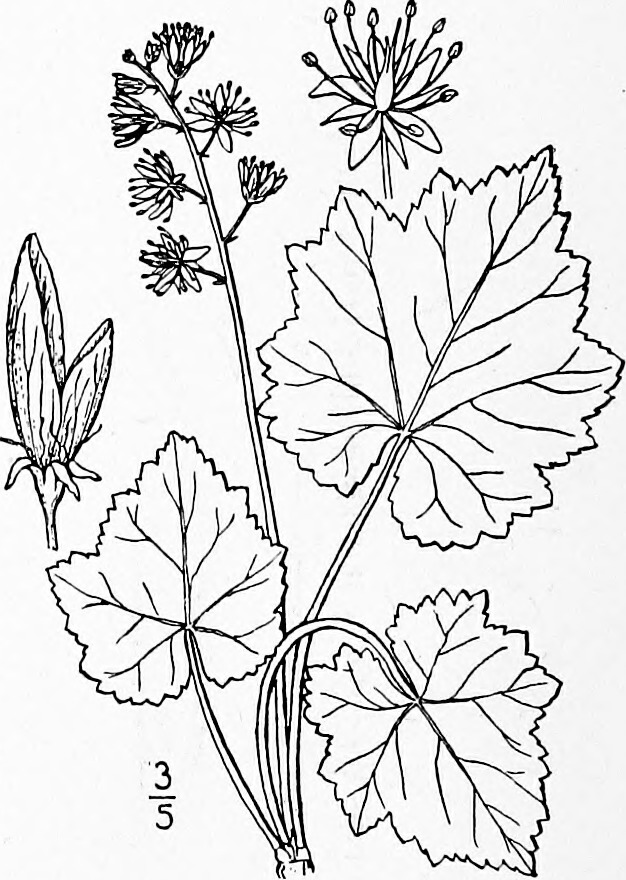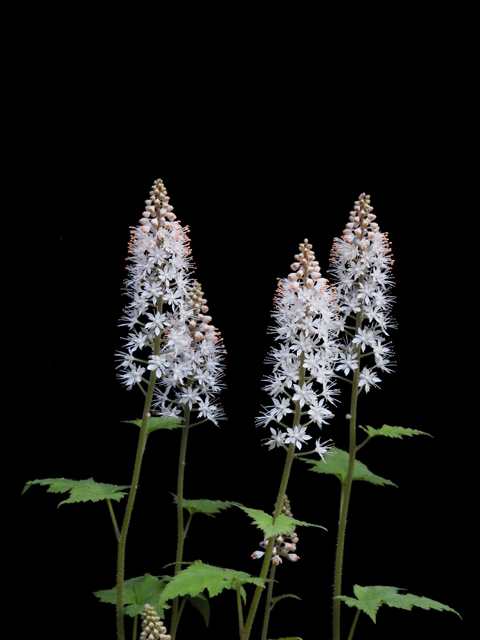Tiarella cordifolia – Foam-flower
Tiarella cordifolia (tea-are-EL-la cor-di-FO-lee-uh)
Foam-flower
Endemic to Eastern and Central North American woodlands, this multi-stemmed perennial will spread with its stolons to produce colonies of foam flowers that at a distance can resemble crashing waves. White flowering Tiarella cordifolia is an ideal choice for a shade garden area that requires a transition from small stature to taller perennials.

From “An illustrated flora of the northern United States…1913
 Foam-flower has gained the Royal Horticultural Society’s Award of Golden Merit, adding to its already impressive resume. Be aware that Tiarella cordifolia needs time to mature before it begins forming colonies in your shade garden. To achieve the mass effect in a new garden, you can plant several plants in a group and divide as they begin to fill the area. Divide the rhizomes or crowns in spring or fall and space them about one foot apart. If patience is your virtue, collecting seed from the mature fruit can be a fun and rewarding activity.
Foam-flower has gained the Royal Horticultural Society’s Award of Golden Merit, adding to its already impressive resume. Be aware that Tiarella cordifolia needs time to mature before it begins forming colonies in your shade garden. To achieve the mass effect in a new garden, you can plant several plants in a group and divide as they begin to fill the area. Divide the rhizomes or crowns in spring or fall and space them about one foot apart. If patience is your virtue, collecting seed from the mature fruit can be a fun and rewarding activity.
Origin:
Tiarella – From the Greek tiara, meaning a little diadem or crown, eluding to the small and delicate flowers.
cordifolia – From the Latin cordi, meaning heart and folia, meaning leaf, referring to the heart-shaped leaves.
Family – Saxifragaceae
Nativity – Eastern and Central North America
Hardiness – USDA Zones 4-8

Tiarella cordifolia inflorescence / Photo credit – Faucette, Steven @Station Cove Falls Trail in South Carolina
Description:
Form – Herbaceous clump-forming perennial producing mounds 6″-10″ in height and width 1′-2′.
Foliage – Deciduous basal foliage arising directly from stolons, with ovate to cordate leaves possessing 3-7 lobes with serrate margins. Leaf senescence produces attractive orange, bronze-red fall color.
Flower – The frothy appearance of the 1/4″ white flowers is generated by the long stamens. Flowers are borne on 12″ tall raceme inflorescence, beginning to bloom in late April until July.
Fruit – Capsules that are not ornamental.
Culture:
Light – Partial shade/ can tolerate some sun
Soil – Moist woodland soils
Propagation – Asexually by division and sexually by seed
Problems – None serious
Utilization – Shade and woodland gardens, along streambanks and native flower areas.
Comments – Tiarella wherryi and T. cordifolia closely resemble each other and are only differentiated by the lack of stolons on T. wherryi. Foam flowered is endangered in New Jersey and Wisconsin.
Ecological benefit – Host plant for 5 species of bees. Compliments a matrix of streambank riparian plant systems.
♥ You can find Foam-flower and other Eastern United States natives at Yellow Spring Farm.


